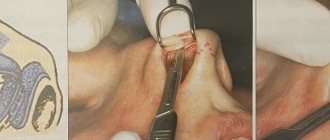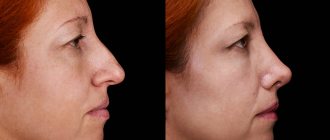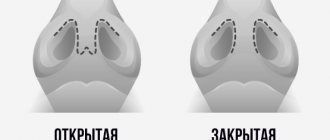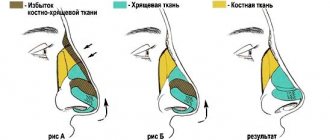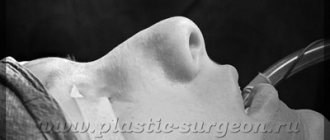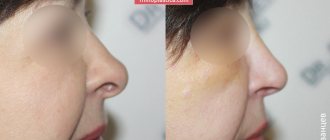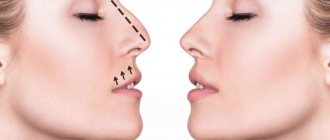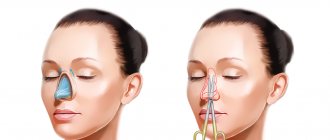What is the essence of the technique
This method can be called a classic of plastic surgery for nose correction. Low-traumatic and minimally invasive, which corresponds to closed rhinoplasty, are trends in modern aesthetic medicine. But the history of the development of rhinosurgery began with the open method. To this day, the proven techniques of the “classical” approach provide successful results. I have a positive attitude towards these surgical interventions, because I know that rehabilitation will take place without unplanned “surprises”, and I can take the liberty of guaranteeing a stable result.
What is the essence of the operation? The incision is made along the columella (septum of the vestibule of the nose). The soft tissues are lifted with a special instrument, exposing the osteochondral frame of the nose. A small scar from the operation remains on the outside of the columella. It becomes invisible after a few months. But this circumstance is very frightening for many patients. Although in fact, few people remember a few millimeters of the incision after 2-3 months.
⇒ INFORMATION: Rhinoplasty - get rid of annoying snoring
How to understand what the patient wants? Are there any established standards of beauty?
There is no clear standard of beauty. Personally, I like noses that have a small hump. As mentioned earlier, a beautiful ideal nose is one that looks natural on the face and is compatible with all other features. Naturalness and harmony are the main standards. And rhinoplasty is now performed in such a way that it is impossible to notice the fact of the operation on the nose. Of course, when modeling the future nose, the patient’s wishes must be taken into account. In fact, it is very easy to understand the desires of clients if you establish trusting communication with them and an open dialogue format.
Photos "Before" and "After"
See more “Before” and “After” photos
Complications after rhinoplasty
In my practice, I encountered 3 complications:
- Suppuration - 5 cases throughout the entire practice. The problem is detected and corrected within 5 days after surgery;
- Perforation of the nasal septum (“hole”) - 2 cases during the entire practice. The problem is detected and corrected within 24 hours after surgery;
- Nosebleeds - 1 case during the entire practice. The problem is detected and corrected within 24 hours after the operation.
The results of the operation (appearance, respiratory function) will be assessed no earlier than after 6 months. Until this period, the process of formation of scar tissue continues, and migrating microedema is possible, which changes both the external picture and appearance of the nose, and does not allow an objective assessment of the completeness of breathing.
It should be noted that according to official data from the American Association of Plastic Surgeons, 20% of patients who have undergone rhinoplasty seek reoperation due to complications or patient dissatisfaction with the results of the operation. In my practice this figure is 1%.
Benefits of Open Rhinoplasty
Rhinoplasty is considered one of the most difficult operations in aesthetic medicine. This is practically microsurgery, since the anatomical structures of the nose are very small in size. The maximum accessible surgical field greatly facilitates the specialist’s work. Visual control of each movement allows you to more confidently make decisions about one or another step during the operation. From my own experience, I can say that during open rhinoplasty of the nose I feel much more confident, since I fully assess the consequences of my actions.
⇒ INFORMATION: Open and closed rhinoplasty: differences and features
Predictability
The second important advantage of this technique is the predictability and stability of the result. I will not hide that in the practice of any surgeon there is a certain percentage of repeated nose corrections. After open operations there are much fewer of them, if not to say that they are absent altogether. Working by touch or within the available space makes a big difference.
Versatility
The technique is suitable for the vast majority of defects:
- alignment of the nasal septum
- length reduction
- hump removal
- narrowing of the wings
- reducing the height of the bridge of the nose
- asymmetry correction
- re-plasty
- reconstruction of the nose after trauma
Only plastic surgery in this way can help a patient with weak cartilages, very thick skin and scar changes on the back of the nose - this is, as a rule, a combination of anatomical features of “sports” noses (sports injuries).
⇒ INFORMATION: How to get rid of a hump on the nose?
Disadvantages of the operation that can be considered insignificant
Traumaticity
During the procedure, the columellar arteries, which are responsible for the blood supply to the tip of the nose, are intersected. This is accompanied by a slightly longer rehabilitation period when compared with the closed method. Within six months to a year, the anatomical structures are completely restored, and the sensitivity of the tip of the nose returns. Outwardly, this has no manifestations, the patient does not experience physical discomfort. Therefore, the emphasis on the increased morbidity of open rhinoplasty can be considered a misconception, a myth or a marketing ploy.
Presence of seam
I repeat: after the operation, the seam is so insignificant that its constant mention in the so-called disadvantages of this technique seems like some kind of far-fetched point.
⇒ INFORMATION: Medical indications for correcting the shape of the nose
What are the indications for surgery?
If we talk about the aesthetic side, then an ideal nose that looks harmonious on the face has its own specific parameters. For example, the size of the nasolabial angle, length, projection of the back and tip, and much more. Before the operation, an examination and assessment of these parameters is carried out. If there are noticeable deviations from those expected, it makes sense to talk about the need for rhinoplasty.
In addition to aesthetic indications, there are also functional indications. These are cases when there are breathing problems, a deviated septum in the nose or other defects that interfere with a comfortable life. During the operation, these defects will also be eliminated.
Application of a piezo device
In line with the current trend towards minimally invasive surgical interventions, bone cutting techniques using piezo-ultrasonic waves have recently been introduced in the field of maxillofacial surgery.
- When using this method, there is no visible damage to adjacent soft tissues generated by the micromovements of the device. The lateral osteotomy technique used in rhinoplasty must not only be accurate, reproducible and safe, but also have minimal postoperative consequences such as ecchymosis and edema.
- The goal of this surgical stage is to mobilize the nasal bones while simultaneously shaping the aesthetic contour.
- The use of a piezo apparatus during rhinoplasty has the additional goal of minimizing the volume of surgical intervention and overcoming most of its complications.
The use of a piezoelectric device is possible only during open correction.
Rhinoplasty of thick skin nose
Dr. Alexander Aleksandrovich Markushin performs any type of plastic surgery on the nose, using modern techniques, certified innovative equipment, instruments and medications.
Rhinoplasty of a nose with thick skin is considered one of the most difficult. Solid practical experience and excellent professional training are required to achieve a good result that guarantees an effective nose transformation.
Plastic surgeon Markushin A.A. deservedly enjoys the trust of patients. He performs complex surgeries every day, always achieving excellent results.
During examination, the presence of thick skin complicates palpation, making it impossible to accurately determine how altered or deformed the osteochondral structures of the nose are. In this case, additional research is required to correctly predict the result of rhinoplasty and avoid errors and complications.
Types of Rhinoplasty Used for Patients with Thick Skin
Alexander Alexandrovich determines the degree of complexity of the upcoming operation, based on objective laboratory tests, the patient’s wishes, and examination.
Rhinoplasty of the nose with thick skin is done in two ways:
- In an open way.
A skin incision is made on the collumella separating the nostrils, then in the vestibule of the nasal cavity along the inner edge of the nostrils for convenient access to the area of the upcoming correction. This allows you to perform any manipulations, seeing the surgical field, quickly reacting to a changing situation, which reduces the risk of postoperative complications.
- In a closed way.
A small incision is made in the area of the vestibule of the nose, which slightly reduces access to the surgical field and complicates the work of the plastic surgeon. The advantage of this method is that there are almost completely no traces of surgical intervention. Small scars disappear within a year.
Important!
When choosing a method, the attending physician tells the patient in detail what it provides and what results to expect from it. 3D modeling allows you to demonstrate to the patient what changes in his appearance will be after rhinoplasty.
The main indications for rhinoplasty of the nose with thick skin
People face the same problems no matter what type of skin nature has given them. At the same time, rhinoplasty of a thick-skinned nose is the most difficult operation, since it cannot guarantee an ideal result. The patient will not be able to get a doll nose with an elegant, small tip. It will be very difficult to achieve the ideal relief.
The operation is ineffective when:
- the tip of the nose needs radical change;
- the bridge of the nose is excessively wide;
- correction of the width of the nostrils or correction of asymmetry of the wings is required;
- a change in value is required for larger sizes.
The result of the operation in the presence of thick nasal skin will be good:
- if you need to get rid of a small hump that spoils the profile;
- when correcting a deviated septum;
- with a slight decrease in the size of the nose.
Most often, patients turn to Dr. Markushin for help not only with isolated aesthetic disorders, but also with combined conditions when there are breathing problems through the nose. More than eighty percent of patients book a consultation with such problems. And only about twenty percent want only an aesthetic improvement in appearance.
Preparing for nose plastic surgery with thick skin
Alexander Alexandrovich carefully examines the upcoming surgical site, taking into account the objective state of the body and the patient’s wishes. By palpating, squeezing different areas of the skin between fingers, the doctor determines how mobile it is.
By palpating the osteochondral base, Alexander Alexandrovich determines the degree of existing deformations. Having established the thickness of the skin, a surgical method is selected to make the upcoming correction. The final result directly depends on the correctness of the chosen rhinoplasty method.
The patient is shown in advance on a computer model the appearance of his new nose after rhinoplasty. The patient must be warned what problems he may encounter after the operation.
Before the operation, you should adhere to some restrictions.
- Completely stop smoking and drinking alcohol a month before the scheduled date.
- Stop taking medications that thin your blood.
- Eat right, eating more vegetables rich in vitamins, minerals, and biologically active substances.
- If you have vision problems, you need to take care of purchasing contact lenses, since you will not be able to wear glasses after surgery.
- Agree in advance at work about a three-week vacation.
On a note!
Rhinoplasty can be done at any time of the year. At the same time, the necessary comfort should be ensured during the rehabilitation period. This is especially important in the first three weeks, since any deviations from the doctor’s instructions can lead to serious complications.
When can rhinoplasty be performed on thick skin?
Having learned that the skin of the nose is very thick, most plastic surgeons immediately refuse to carry out aesthetic correction.
The emergence of innovative equipment and tools makes it possible to cope with complex tasks without any problems. Only experienced specialists, such as Dr. Markushin, who have experience working with thick skin of the nose, perform rhinoplasty of the nose with thick skin, achieving excellent results.
Patients over 18 years of age can become a patient of Alexander Alexandrovich Markushin. Surgery can be postponed during pregnancy, regardless of the period, for mothers who are breastfeeding a baby, or for women who have started their cycle.
Rhinoplasty cannot be done if:
- exacerbation of chronic diseases;
- influenza, ARVI, other infectious, seasonal diseases accompanied by a sharp increase in temperature;
- serious mental disorders;
- the presence of any type of tumor, regardless of its location;
- hormonal or metabolic disorders;
- detection of blood diseases affecting clotting;
- dermatological diseases;
- chronic liver or kidney diseases;
- cardiovascular pathology.
If necessary, additional consultations with related specialists are prescribed to obtain objective data about the condition of the patient’s body.
Surgery for thick nasal skin
Rhinoplasty of a thick-skinned nose is technically not much different from classical methods of working with thin or medium-thick skin.
However, a surgeon may encounter a number of serious problems during his work:
- difficulties in predicting the final result.
- slight gap in possibilities for aesthetic correction of the shape of the nose.
- Shape memory can cause the skin of the nose to return to its original state.
- the risk of rough scars appearing on the operated area.
- the result of the operation may be minimally expressed.
By using piezo technology for rhinoplasty of a thick-skinned nose, the risk of the formation of extensive hematomas and edema is minimized.
After the operation is completed, turundas are inserted into the nasal passages to fix the new shape, and a splint is applied to the surface of the nose.
Features of rehabilitation after rhinoplasty of a nose with thick skin
The patient must prepare for a long recovery, since regeneration of thick skin is slow.
By strictly following the instructions of your doctor, you can speed up the recovery process:
- in the first week, do not touch your nose, do not remove the turund yourself,
- do not wet the plaster cast when washing,
- take all medications prescribed by your doctor exactly as scheduled,
- no excessive exercise, including sports or yoga for the first four weeks,
- rest only in a half-sitting position,
- exclude the possibility of exposure to ultraviolet radiation on the operated area,
- Do not drink hot drinks after surgery.
Rhinoplasty of a nose with thick skin cannot boast of a high level of aesthetic correction, but Alexander Alexandrovich, having extensive experience in correcting thick-skinned noses, can easily eliminate problems in the aesthetics of the nose and in improving nasal breathing.
How is the operation performed?
The procedure is performed under general anesthesia. The dosage of the drug, its administration and the subsequent recovery of the patient from drug-induced sleep is controlled by an anesthesiologist. The duration of a surgeon's work depends on the number and complexity of the tasks facing him. Let's look at the procedure using the example of correcting a hump and the tip of the nose:
- The surgeon makes an incision along the inner surfaces of the wings of the nostrils, along the edge of the lower lateral cartilages with the intersection of the skin of the columella.
- Soft tissues are pulled upward with a special hook. Then the cartilage is separated from them using sharp scissors.
- The cartilaginous part of the hump is cut off with a scalpel. If necessary, a bony protrusion is excised with a special instrument – an osteotome.
- An osteotomy is performed on both sides of the dorsum to displace the bone structures and close the “lid” of the nose. The latter can also be a transplant.
- The surgeon excises parts of the lower lateral cartilages, then their domes are sutured to symmetrically narrow the tip of the nose.
- The skin returns to its place. If necessary, the shape and size of the nostrils are adjusted.
- Cosmetic stitches are applied, silicone air ducts are inserted into the nasal passages, and the back is secured with plaster (Denver splint).
On average, such plastic surgery takes 2-3 hours, after which the patient is transferred to a ward under the supervision of doctors, where he may have to spend a day or two until his condition is completely stabilized.
⇒ INFORMATION: What absolutely should not be done after rhinoplasty
Recommendations and restrictions at the initial stage of rehabilitation
- Take medications prescribed by your doctor - anti-inflammatory, painkillers, antibiotics.
- No activity, no sports! Do not lift anything heavy, do not make sudden movements with your head.
- No alcohol - it thins the blood, causes swelling and interferes with tissue regeneration. You will have to give up too hot or spicy foods and drinks.
- Sleep only on your back - you can put pillows on the sides so as not to roll over in your sleep.
- If you wear glasses, you will have to temporarily switch to contact lenses: even light frames put pressure on the bridge of the nose and can deform a non-healed nose.
- Avoid swimming in public places - ponds, swimming pools - due to the risk of infection.
- You can wash your head, but not by tilting it down, but on the contrary, by slightly tilting it back, like in a hairdresser.
- With the doctor's permission, you can use Traumeel S and Lyoton gels to speed up the resorption of hematomas.
⇒ INFO: Swelling after rhinoplasty
Are there any special, unique secrets to performing rhinoplasty?
Rhinoplasty in any case is both a very complex and unique operation. There are no identical noses in nature; each person has his own set of parameters for location, shape and other indicators. Therefore, a good surgeon cannot work according to the same template with every patient. For any combination of options, a different action plan is selected.
Surgeons performing rhinoplasty always have some kind of “tricks”. I also have my own “tricks” and developments, but I cannot call this a full-fledged author’s technique. And there are absolutely no secrets - my colleagues and I are always ready to exchange experiences.
Price in Moscow
How much does open rhinoplasty cost? Call to schedule a consultation to find out the exact amount of the operation in your case and to set a date. Phone number to make an appointment +7 (985) 570-71-71
| Rhinoplasty (nose job) | Price |
| Rhinoplasty | 200 000 |
| Rhinoseptoplasty | 250 000 |
| Plastic surgery of the tip of the nose | 160 000 |
| Nose wing correction | 100 000 |
| Revision rhinoplasty | 300 000 |
Rehabilitation after nose surgery
Immediately after the operation, the patient is in a ward in the clinic. In 95% of cases, the patient can return home within a day, in 5% - after two days.
The patient must come for an examination 5, 7 and 10 days after surgery;
The sutures are removed on the 7th day.
Bruises persist for 5-6 days, swelling in the nose area persists for 7-10 days.
The protective plate and internal splints are worn for 7-10 days.
What does the protective plate look like (not plaster!):
Protective plate for the nose after rhinoplasty ©Dikarev Alexey Sergeevich
What does the nose and face look like immediately after removing the protective plate and splints:
Nose surgery in 7 days ©Dikarev Alexey Sergeevich
I have collected detailed recommendations for the postoperative period in a separate file.
Rehabilitation after nose surgery - rhinoplasty
What to do after rhinoplasty
Rehabilitation after nose surgery - rhinoplasty
After the operation - rehabilitation for 7 days (read above), after rehabilitation - scheduled examinations, which should be carried out in a month, six months, a year. Inspections are free.
What not to after surgery:
- Remove and adjust the protective plate;
- Remove the internal splints;
- Squeeze, move, press on the nose;
- Lift weights;
- Sunbathe, do cosmetic and cosmetic procedures on the nose for 3 months after surgery.
If the protective plate begins to come off, you feel pain, or want to take medicine, let me know right away and we’ll sort it out.

